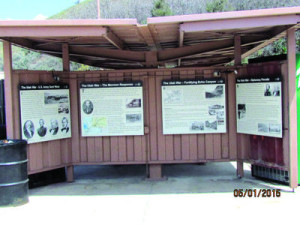On Saturday, 13 June 2015, the Centerville Chapter of the Sons of Utah Pioneers dedicated a display of historic plaques in Echo Canyon. The plaques will serve in helping to fill in some of the blanks that historians have not been able to find answers to until now concerning the movement of U.S. Army troops from Fort Bridger, Wyoming, to the Salt Lake Valley.
History records that during the winter of 1857-1858, approximately one-fourth of the United States Army (2,500 soldiers) camped near Fort Bridger, Wyoming, and waited for spring when they planned to fight their way through Echo Canyon — not barring the Utah militia and the fortifications that were already in place there. From Echo Canyon, they were to travel over Big Mountain and eventually arrive in the Salt Lake Valley.
 Why was the U.S. Army sent to Utah? What was the response of the Mormons when they learned that the Army was on its way to Utah? What fortifications did the Army make in Echo Canyon? Why didn’t any fighting take place? Historians have long pondered such questions. The answer to those questions can be found on four (36”x 46”) plaques of high pressure Laminate placed in Echo Canyon on I-80 at the mouth of Echo Canyon, across from the Visitor Information Center at rest area #170.
Why was the U.S. Army sent to Utah? What was the response of the Mormons when they learned that the Army was on its way to Utah? What fortifications did the Army make in Echo Canyon? Why didn’t any fighting take place? Historians have long pondered such questions. The answer to those questions can be found on four (36”x 46”) plaques of high pressure Laminate placed in Echo Canyon on I-80 at the mouth of Echo Canyon, across from the Visitor Information Center at rest area #170.
Wikipedia gives a little more clarification on the events that took place in 1857-1858 in its article on the Utah War.
President James Buchanan sent U.S. forces to the Utah Territory in 1857-1858. This became known as the Utah Expedition. The Mormons, learning of the impending arrival of the U.S. military forces, feared that they were sent to annihilate them, and made preparations to defend themselves. Though the objective was to avoid bloodshed and loss of life, both sides prepared for war. Firearms were manufactured or repaired by the Mormons, scythes were turned into bayonets, and long-unused sabres were burnished and sharpened.
The Mormons’ strategy was to hinder and weaken the forces rather than engaging them directly. It is recorded that Daniel H. Wells, Lieutenant-General of the Nauvoo Legion, instructed Major Joseph Taylor:
On ascertaining the locality or route of the troops, proceed at once to annoy them in every possible way. Use every exertion to stampede their animals and set fire to their trains. Burn the whole country before them and on their flanks. Keep them from sleeping, by night surprises; blockade the road by felling trees or destroying the river fords where you can. Watch for opportunities to set fire to the grass on their windward, so as, if possible, to envelop their trains. Leave no grass before them that can be burned. Keep your men concealed as much as possible, and guard against surprise.
The Mormons were able to block the entrance of the U.S. Army into the Salt Lake Valley, and weakened them by cutting them off from receiving provisions. The confrontation between the Nauvoo Legion and the U.S. Army involved some destruction of property and a few brief skirmishes in what is today southwestern Wyoming, but no battles occurred between the contending military forces.
The rest of the story is that the United States Army (comprised of 3,000 men by the time they reached the Salt Lake Valley), under the command of Colonel Johnston, passed down South Temple and did not stop until they reached the west side of the Jordan River. A few days later, they moved 40 miles south and established Camp Floyd, and by mid-1861, the soldiers of the U.S. Army had left Utah to participate in the Civil War.
About Keith L. Brown
Keith L. Brown is a convert to The Church of Jesus Christ of Latter-day Saints, having been born and raised Baptist. He was studying to be a Baptist minister at the time of his conversion to the LDS faith. He was baptized on 10 March 1998 in Reykjavik, Iceland while serving on active duty in the United States Navy in Keflavic, Iceland. He currently serves as the First Assistant to the High Priest Group for the Annapolis, Maryland Ward. He is a 30-year honorably retired United States Navy Veteran.


 Watch a video about the restoration of the gospel on lds.org
Watch a video about the restoration of the gospel on lds.org